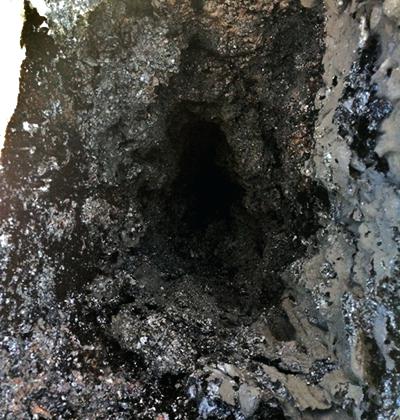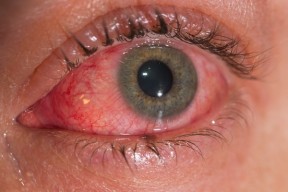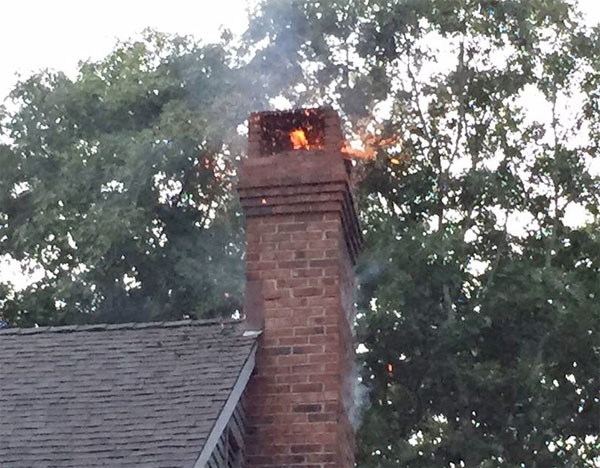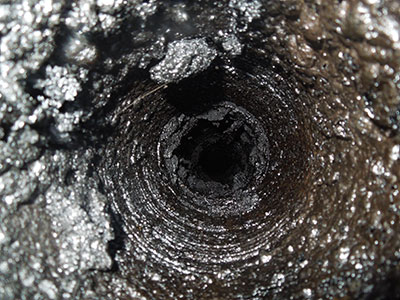What is Creosote? Why Is It Dangerous?
What is Creosote? Why Is It Dangerous?
Not so long ago we received a call from a new chimney service customer who lives in Howard County. She was asking what is creosote and how to deal with it. We will tell you the same as we told her. Creosote is a highly flammable residue that can build up in chimneys and cause serious problems. These problems can especially serious if they go unnoticed for years. This article has been written to educate homeowners about how creosote is created and why it is dangerous.
What is creosote?
Creosote is a sticky, highly flammable substance that is a natural byproduct of chimney smoke. Creosote builds up inside of chimneys over time.

How Does Creosote Form?
You now know what creosote, but before starting on how to deal with it we first need to understand how it forms. Smoke from burning wood cools as it exits the chimney. In some cases, the smoke cools to the point that it does not exit the chimney. The cooled down smoke sticks to the internal parts of the chimney forming into creosote. Creosote is sticky and highly flammable. Creosote can form from burning any kind of fossil fuels, but it tends to form most quickly in wood-burning fireplaces. Here’s what happens, phase by phase.
Phase 1: Wood or similar materials burn, and the smoke is carried away via the flue outdoors – everything is working as it should. However, that smoke is both very hot, and filled with a lot of particles, including particles of carbon and oils that were vaporized by the fire. As the smoke travels, these particles combine and hit the sides of the flue, getting attached. At first, this forms only a light layer of slightly sticky, burnt materials that can be scrubbed away with little difficulty.
Phase 2: Over time, creosote builds up to a thicker layer. If you’ve ever seen fresh asphalt on a road, you have some idea of what this substance looks like. The combination of heat and resin from wood creates a tarry substance that’s thick, sticky and quite difficult to remove. At this point, it takes a lot of scraping to get rid of the creosote, and the job is best left to professionals.
Phase 3: In time, the creosote layer becomes literally baked onto the inside of the chimney, a thick, hardened substance that may ooze or drip when exposed to high temperatures. Because this version of creosote is so thick and durable, it can be extremely difficult to remove. At this stage, it may also be causing problems with your chimney airflow.

Creosote Dangers
Health Hazards
You can probably see that creosote can become pretty annoying. But what makes it dangerous? Well, that baked and blackened substance can burn and exude fumes over time. Particularly in fireplaces used for heating, those fumes can enter your house and circulate around, where they cause all kinds of health problems. Notable issues include:



Fire Hazards

There is a second set of dangers associated with creosote pertain to situations that could result in chimney fires.
Decreased Ventilation
Chimney flues are designed to encourage airflow as much as possible. After a lot of creosote build-up, airflow decreases. This means that more heat stays in the chimney, exposing both chimney materials and the creosote to more heat than they would otherwise endure. This also occurs with clogged or mismanaged chimneys!
Flammable Deposits
Creosote itself is flammable. Due to its composition, it can be very hot and can be very difficult to put out. Unfortunately, the chimney is one of the worst places in a house for this kind of fire to start: Chimney fires can quickly spread to the roof and throughout a house, and many devastating house fires start in the chimney, often caused by unknown creosote deposits.

Tips on Preventing Creosote from Building Up
Since creosote can be difficult and expensive to remove, the best solution is to prevent it from building up at all. But what can the average homeowner with a fossil fuel fireplace do about this? Here are several chimney maintenance tips to keep in mind:
Choose the Best Fireplace & Stove Fuels
You can reduce the amount of creosote buildup by burning fuels that will have the least impact on your chimney. For wood-burning fireplaces, that means only using fully dried, “seasoned” wood with no moisture, which will create very little residue when it burns.
Stay Away from Chemical Cleaners
Chemical cleaners are special logs or sticks you can buy and burn in your fireplace to help reduce the amount of creosote that forms. You have to burn chemical cleaners every time you use the fireplace for them to be effective, but if all you have is green wood, then chemical cleaners can help decrease creosote buildup in your chimney.
Schedule a Professional Chimney Inspection Every Year
Without a doubt, regularly chimney inspections and sweeps are the best way to prevent creosote buildup. It is also very important for the health of your fireplace! And family. If you don’t know the history of your fireplace or how well it was maintained in the past, then you don’t know how much creosote was built up before you started using the fireplace. On the other hand, if you’ve been using the fireplace for years without an inspection, even more creosote could have built up during this time. Either way, a professional inspection is a good idea: Fireplace and chimney experts can take a look at the health of your chimney, see what the creosote levels are, and recommend the best cleaning options.
You can find out more by contacting us at All Pro Chimney to arrange an inspection or ask more specific questions about your fireplace and chimney!
